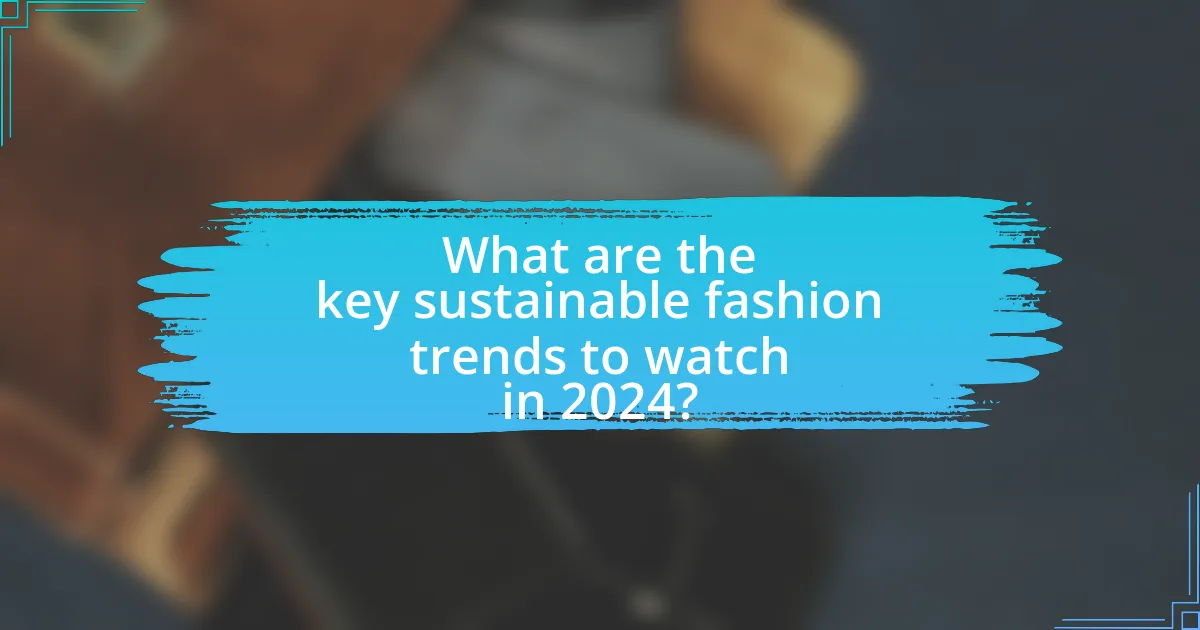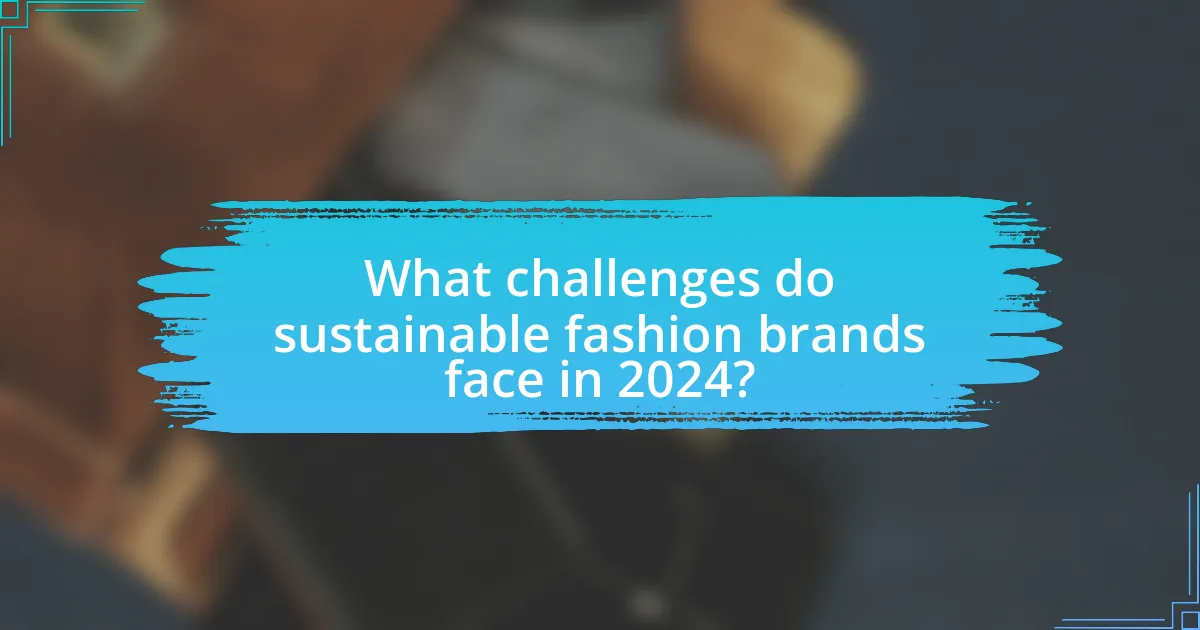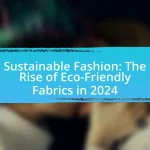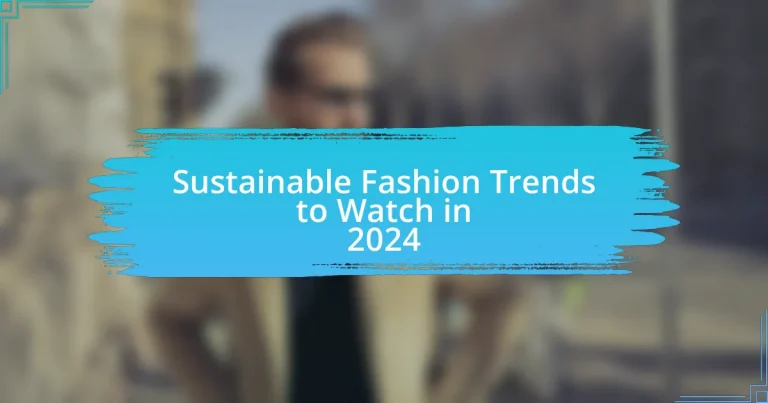The article focuses on sustainable fashion trends to watch in 2024, highlighting key developments such as the rise of circular fashion, the use of biodegradable materials, and increased transparency in supply chains. It examines how consumer preferences are shaping these trends, driven by values like environmental consciousness and ethical labor practices. The article also discusses innovations in sustainable materials, the role of technology in enhancing sustainability, and the challenges brands face in adopting eco-friendly practices. Additionally, it outlines practical steps consumers can take to support sustainable fashion and identify truly sustainable brands.

What are the key sustainable fashion trends to watch in 2024?
The key sustainable fashion trends to watch in 2024 include the rise of circular fashion, increased use of biodegradable materials, and a focus on transparency in supply chains. Circular fashion emphasizes the reuse and recycling of garments, reducing waste and promoting sustainability. Biodegradable materials, such as organic cotton and innovative fabrics made from natural resources, are gaining traction as brands seek to minimize their environmental impact. Transparency in supply chains is becoming essential, with consumers demanding to know the origins of their clothing and the ethical practices involved in production. These trends reflect a growing commitment to sustainability within the fashion industry, driven by consumer awareness and regulatory pressures.
How are consumer preferences shaping sustainable fashion in 2024?
Consumer preferences are significantly shaping sustainable fashion in 2024 by driving demand for eco-friendly materials and ethical production practices. As consumers increasingly prioritize sustainability, brands are responding by adopting practices such as using organic fabrics, reducing waste, and ensuring fair labor conditions. For instance, a survey by McKinsey & Company in 2023 revealed that 67% of consumers consider sustainability when making fashion purchases, indicating a clear shift towards environmentally conscious buying habits. This trend compels brands to innovate and align their offerings with consumer values, ultimately transforming the fashion industry towards more sustainable practices.
What specific values are driving consumer choices in sustainable fashion?
Consumer choices in sustainable fashion are primarily driven by values such as environmental consciousness, ethical labor practices, and social responsibility. Environmental consciousness motivates consumers to seek products that minimize ecological impact, as evidenced by a 2021 survey indicating that 66% of global consumers are willing to pay more for sustainable brands. Ethical labor practices are also crucial, with 58% of consumers prioritizing brands that ensure fair wages and safe working conditions for workers. Additionally, social responsibility resonates with consumers, as they increasingly prefer brands that contribute positively to communities and advocate for social justice. These values collectively shape purchasing decisions, reflecting a growing demand for transparency and accountability in the fashion industry.
How does transparency influence consumer trust in sustainable brands?
Transparency significantly enhances consumer trust in sustainable brands by providing clear and accessible information about sourcing, production processes, and environmental impact. When brands openly share their practices, consumers feel more informed and empowered to make ethical purchasing decisions. Research indicates that 94% of consumers are likely to be loyal to a brand that offers complete transparency, as highlighted in a study by Label Insight. This level of openness fosters a sense of accountability and authenticity, which are crucial for building long-term relationships with consumers in the sustainable fashion sector.
What innovations are emerging in sustainable fashion materials?
Innovations in sustainable fashion materials include the development of bio-based textiles, such as mycelium leather and algae-derived fabrics. Mycelium leather, made from the root structure of mushrooms, offers a biodegradable alternative to traditional leather, reducing environmental impact. Algae-derived fabrics utilize renewable resources, significantly lowering carbon emissions compared to conventional textile production. Additionally, advancements in recycled materials, like ocean plastics transformed into fibers, are gaining traction, promoting circular fashion practices. These innovations are supported by research indicating that sustainable materials can reduce the fashion industry’s carbon footprint by up to 80% when compared to conventional materials.
Which eco-friendly materials are gaining popularity in 2024?
In 2024, materials such as organic cotton, Tencel, and recycled polyester are gaining popularity in the eco-friendly fashion sector. Organic cotton is favored for its reduced environmental impact compared to conventional cotton, as it is grown without harmful pesticides and fertilizers. Tencel, made from sustainably sourced wood pulp, is known for its biodegradability and low water usage during production. Recycled polyester, derived from post-consumer plastic bottles, is increasingly used to reduce waste and promote circular fashion. These materials reflect a growing consumer demand for sustainability and ethical production practices in the fashion industry.
How are brands incorporating recycled materials into their collections?
Brands are incorporating recycled materials into their collections by utilizing fabrics made from post-consumer waste, such as plastic bottles and discarded textiles. For instance, companies like Adidas have developed shoes made from Parley Ocean Plastic, which repurposes ocean waste into high-performance footwear. Additionally, brands like H&M and Stella McCartney are integrating recycled polyester and cotton into their clothing lines, significantly reducing the environmental impact associated with virgin material production. This shift is supported by a growing consumer demand for sustainable practices, with a report from McKinsey indicating that 66% of consumers are willing to pay more for sustainable brands.
What role does technology play in sustainable fashion trends?
Technology plays a crucial role in sustainable fashion trends by enabling innovative practices that reduce environmental impact. For instance, advancements in materials science have led to the development of biodegradable fabrics and recycled textiles, which significantly lower waste in the fashion industry. Additionally, technologies such as 3D printing and digital design allow for more efficient production processes, minimizing resource consumption and reducing carbon footprints. According to a report by McKinsey & Company, the adoption of digital technologies in fashion could reduce greenhouse gas emissions by up to 30% by 2030. This demonstrates that technology not only supports sustainable practices but also drives significant change in the industry’s approach to environmental responsibility.
How are digital platforms enhancing sustainable fashion visibility?
Digital platforms are enhancing sustainable fashion visibility by providing accessible channels for brands to showcase their eco-friendly practices and products. These platforms, such as social media, e-commerce websites, and dedicated sustainable fashion marketplaces, allow brands to reach a wider audience and engage consumers directly. For instance, Instagram and TikTok enable brands to share compelling visual content that highlights sustainable materials and ethical production processes, increasing consumer awareness and interest. Additionally, data from a 2022 McKinsey report indicates that online searches for sustainable fashion have surged by 75% in recent years, demonstrating the effectiveness of digital platforms in promoting sustainable practices.
What technologies are being used to improve supply chain sustainability?
Technologies such as blockchain, artificial intelligence (AI), and the Internet of Things (IoT) are being used to improve supply chain sustainability. Blockchain enhances transparency by providing an immutable record of transactions, allowing stakeholders to trace the origin of materials and ensure ethical sourcing. AI optimizes logistics and inventory management, reducing waste and energy consumption through predictive analytics. IoT devices enable real-time monitoring of supply chain processes, facilitating efficient resource use and minimizing environmental impact. These technologies collectively contribute to a more sustainable supply chain by promoting accountability, efficiency, and reduced carbon footprints.

How are brands adapting to the sustainable fashion movement in 2024?
Brands are adapting to the sustainable fashion movement in 2024 by implementing circular economy practices, utilizing eco-friendly materials, and enhancing transparency in their supply chains. For instance, many brands are adopting recycling programs that allow consumers to return used garments for repurposing, thereby reducing waste. Additionally, the use of organic cotton, recycled polyester, and innovative materials like Tencel is becoming more prevalent, as these materials have a lower environmental impact compared to conventional fabrics. Furthermore, brands are increasingly disclosing their sourcing and manufacturing processes, which aligns with consumer demand for ethical practices; a 2023 survey indicated that 66% of consumers prefer brands that are transparent about their sustainability efforts.
What strategies are brands implementing to promote sustainability?
Brands are implementing strategies such as adopting circular economy practices, utilizing sustainable materials, and enhancing transparency in their supply chains to promote sustainability. For instance, many fashion brands are shifting towards circularity by designing products that can be easily recycled or repurposed, thereby reducing waste. Additionally, the use of organic cotton, recycled polyester, and other eco-friendly materials is becoming more prevalent, as these materials have a lower environmental impact compared to conventional options. Furthermore, brands are increasingly providing detailed information about their sourcing and manufacturing processes, which fosters consumer trust and encourages responsible purchasing decisions. According to a 2022 McKinsey report, 67% of consumers consider sustainability when making fashion purchases, highlighting the effectiveness of these strategies in aligning with consumer values.
How are collaborations between brands and environmental organizations evolving?
Collaborations between brands and environmental organizations are evolving towards more integrated and impactful partnerships that prioritize sustainability. Brands are increasingly aligning their business models with environmental goals, often co-developing products that utilize sustainable materials and practices. For instance, in 2023, major fashion brands like H&M and Stella McCartney partnered with organizations such as the Ellen MacArthur Foundation to promote circular fashion initiatives, demonstrating a commitment to reducing waste and enhancing resource efficiency. This shift reflects a growing recognition of the importance of sustainability in consumer purchasing decisions, with 66% of global consumers willing to pay more for sustainable brands, according to a 2022 Nielsen report.
What marketing approaches are effective for sustainable fashion brands?
Effective marketing approaches for sustainable fashion brands include storytelling, influencer partnerships, and transparency in sourcing. Storytelling engages consumers by highlighting the brand’s mission and the environmental impact of their products, fostering an emotional connection. Influencer partnerships leverage the reach of eco-conscious influencers to promote sustainable practices and products, increasing brand visibility among target audiences. Transparency in sourcing builds trust by providing consumers with information about materials, production processes, and ethical practices, which is crucial as studies show that 66% of consumers are willing to pay more for sustainable brands. These approaches collectively enhance brand loyalty and drive sales in the competitive sustainable fashion market.
How are fashion events and influencers impacting sustainable fashion trends?
Fashion events and influencers significantly impact sustainable fashion trends by promoting eco-friendly practices and raising awareness among consumers. Major fashion events, such as Fashion Weeks, increasingly feature sustainable brands and initiatives, showcasing innovative materials and ethical production methods. For instance, the Copenhagen Fashion Summit has become a leading platform for discussing sustainability in the industry, influencing brands to adopt greener practices. Influencers, with their vast reach on social media, amplify these messages by endorsing sustainable products and educating their followers about the importance of conscious consumption. Research indicates that 70% of consumers are more likely to purchase from brands that are environmentally responsible, highlighting the effectiveness of influencers in shaping consumer behavior towards sustainability.
What role do fashion weeks play in promoting sustainable practices?
Fashion weeks play a crucial role in promoting sustainable practices by providing a global platform for designers to showcase eco-friendly collections and innovative materials. These events increasingly feature brands that prioritize sustainability, thereby influencing industry standards and consumer expectations. For instance, the Copenhagen Fashion Week has implemented a sustainability action plan that requires participating brands to meet specific environmental criteria, demonstrating a commitment to reducing waste and carbon footprints. This shift not only raises awareness among attendees and the media but also encourages other fashion weeks to adopt similar initiatives, ultimately driving the industry towards more sustainable practices.
How are influencers shaping consumer perceptions of sustainable fashion?
Influencers are significantly shaping consumer perceptions of sustainable fashion by promoting eco-friendly brands and practices through their platforms. Their large followings and relatable content create a sense of trust and authenticity, which encourages consumers to adopt sustainable choices. For instance, a study by the University of Southern California found that 70% of consumers are influenced by social media when making purchasing decisions, particularly in the fashion sector. This demonstrates that influencers can effectively drive awareness and acceptance of sustainable fashion, leading to increased demand for environmentally responsible products.

What challenges do sustainable fashion brands face in 2024?
Sustainable fashion brands face significant challenges in 2024, primarily due to high production costs and consumer awareness. The shift towards sustainable materials often results in increased expenses, making it difficult for brands to maintain competitive pricing. Additionally, consumers are becoming more informed about sustainability issues, leading to higher expectations for transparency and ethical practices. According to a 2023 McKinsey report, 67% of consumers consider sustainability when making purchasing decisions, pressuring brands to align their practices with consumer values. This combination of financial constraints and heightened consumer scrutiny creates a complex landscape for sustainable fashion brands in 2024.
What are the main barriers to widespread adoption of sustainable practices?
The main barriers to widespread adoption of sustainable practices include high costs, lack of consumer awareness, and insufficient infrastructure. High costs deter businesses from implementing sustainable methods, as initial investments can be significant; for example, sustainable materials often cost more than conventional ones. Lack of consumer awareness limits demand for sustainable products, with studies indicating that many consumers are unaware of the environmental impact of their choices. Additionally, insufficient infrastructure, such as recycling facilities and supply chain adaptations, hinders the effective implementation of sustainable practices across industries.
How do cost and accessibility affect sustainable fashion choices?
Cost and accessibility significantly influence sustainable fashion choices by determining the affordability and availability of eco-friendly options. High costs associated with sustainable materials and ethical production often limit consumer access, making it challenging for individuals to choose sustainable brands over conventional ones. For instance, a 2021 report by McKinsey & Company indicated that 66% of consumers consider price as a primary factor when purchasing clothing, which can deter them from opting for higher-priced sustainable alternatives. Additionally, limited availability of sustainable fashion in mainstream retail channels further restricts consumer choices, as many sustainable brands operate online or in niche markets. This combination of cost and accessibility creates barriers that can hinder the widespread adoption of sustainable fashion practices among consumers.
What misconceptions exist about sustainable fashion that hinder its growth?
Misconceptions about sustainable fashion that hinder its growth include the belief that sustainable clothing is always more expensive, that it lacks style and variety, and that it is only a trend rather than a necessary shift in the industry. Many consumers assume that sustainable brands charge higher prices due to production costs, but studies show that sustainable practices can lead to long-term savings and efficiency. Additionally, the perception that sustainable fashion is unattractive is challenged by the increasing number of stylish options available from eco-conscious brands. Lastly, viewing sustainable fashion as a fleeting trend undermines the urgent need for environmental responsibility, as the fashion industry is one of the largest polluters globally, contributing to significant waste and carbon emissions.
How can consumers support sustainable fashion in 2024?
Consumers can support sustainable fashion in 2024 by prioritizing purchases from brands that demonstrate ethical practices and transparency in their supply chains. This includes choosing companies that use eco-friendly materials, implement fair labor practices, and engage in sustainable production methods. According to a 2022 report by McKinsey & Company, 66% of consumers are willing to pay more for sustainable brands, indicating a growing demand for responsible fashion. Additionally, consumers can extend the lifecycle of their clothing by opting for second-hand shopping, participating in clothing swaps, and properly recycling garments, which reduces waste and promotes a circular economy.
What practical steps can consumers take to make sustainable choices?
Consumers can make sustainable choices by prioritizing the purchase of eco-friendly products, such as clothing made from organic or recycled materials. Research indicates that the fashion industry is responsible for approximately 10% of global carbon emissions, highlighting the importance of selecting brands that implement sustainable practices. Additionally, consumers can reduce waste by opting for second-hand clothing, which extends the lifecycle of garments and minimizes the demand for new production. Supporting local and ethical brands further contributes to sustainability by reducing transportation emissions and promoting fair labor practices. By making these informed choices, consumers can significantly impact the environmental footprint of the fashion industry.
How can consumers identify truly sustainable brands?
Consumers can identify truly sustainable brands by examining their transparency, certifications, and supply chain practices. Brands that openly share information about their sourcing, production processes, and environmental impact demonstrate a commitment to sustainability. Certifications such as Fair Trade, Global Organic Textile Standard (GOTS), and the Responsible Wool Standard (RWS) provide credible validation of a brand’s sustainable practices. Additionally, consumers should look for brands that prioritize ethical labor practices and use eco-friendly materials, as these factors contribute to a brand’s overall sustainability. Research indicates that brands with transparent supply chains and recognized certifications are more likely to adhere to sustainable practices, making them easier for consumers to identify.
What are the best practices for engaging with sustainable fashion trends?
The best practices for engaging with sustainable fashion trends include prioritizing eco-friendly materials, supporting ethical brands, and promoting circular fashion. Eco-friendly materials, such as organic cotton and recycled fabrics, reduce environmental impact and resource consumption. Supporting ethical brands ensures fair labor practices and transparency in production, which is crucial for sustainability. Promoting circular fashion, through initiatives like clothing swaps and upcycling, extends the lifecycle of garments and minimizes waste. According to a report by McKinsey & Company, sustainable fashion can reduce greenhouse gas emissions by up to 30% by 2030 if these practices are widely adopted.

















